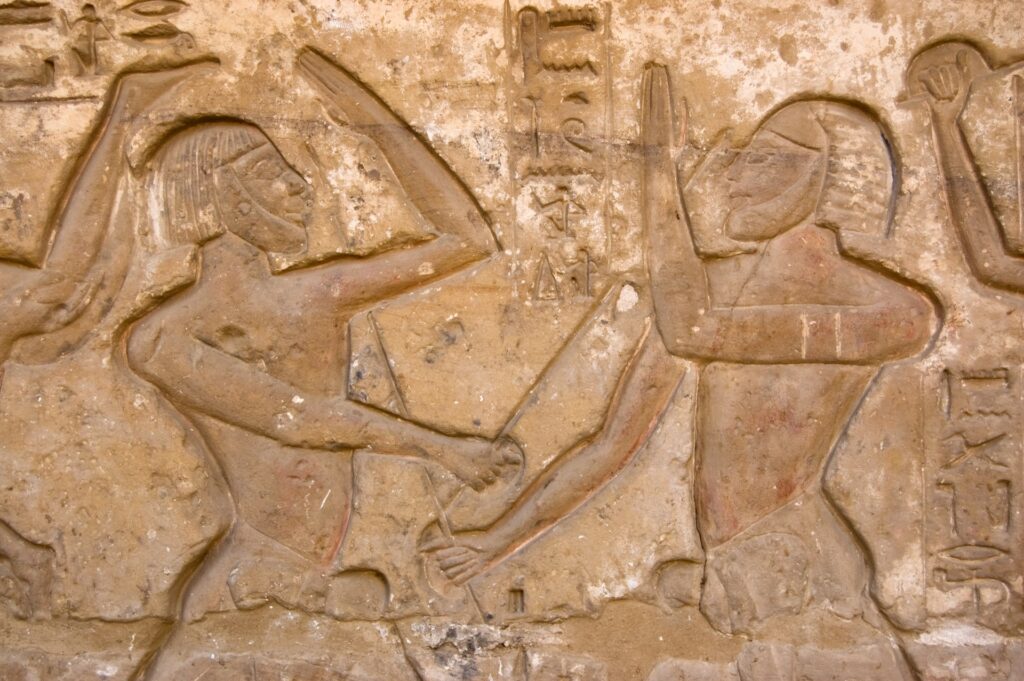Multiple cultures have evidence of combat martial arts diverging to dance with the use of weapons, as battles were recollected, or as a way to teach complex combat techniques. Ancient carvings in rock, petroglyphs, documents, and the performance of cultural dances show the ancient history of these and other ancient martial arts and their evolution through culture and history.
Tahtib Stick Fighting
Early evidence of Tahtib stick fighting was discovered in engravings on the necropolis in Egypt. These engravings and reliefs have been found in more than 35 tombs, and the consistency of details in the depictions provides solid proof that Tahtib was used as a martial art alongside archery and wrestling. Initially, over 4,500 years ago, it is thought that Tahtib was reserved for the higher classes, with depictions of pharaohs, royalty, and elite soldiers using the sticks. Egyptians placed a high value on physical fitness, which they believed led to endurance and an esteemed afterlife. This idea of a better afterlife led to the lower classes learning Tahtib via demonstrations by retired soldiers.
The emergence of Christianity is thought to be one of the prominent catalysts for the reason that Tahtib stick fighting transitioned from a martial art to becoming more of a ceremonial dance that was performed at special events and celebrations. As Tahtib performances progressed, the music played and the physical exertion during the performances, were thought to elicit communication with the gods. As Tahtib stick fighting transitioned into ceremonial dance, the lines became blurred between when the martial arts fighting style became more of a dance related activity.
Capoeira
Another example of a martial art incorporated into dance is Capoeira. In the 16th century, evidence of this acrobatic martial arts style was found in Brazil, which was developed and practiced by enslaved Africans. The effectiveness of using sticks and movements was frowned upon by those in power and was dangerous to train. Those teaching similar techniques did so in fear of being accused of training rebels who wanted to retaliate against those in power. The use of sticks and movements that appeared to honor battles and the addition of music helped disguise combat techniques from prying eyes.
Mbende Jerusarema
Mbende Jerusarema was a martial art technique used by tribes in Zimbabwe. This martial art is now considered a dance that re-enacts battle and highlights past strategies. It is preserved today in Zimbabwe by the Zezuru people. What is regarded as a war dance teaches how to fight battles and win against opposition. Key events resulting in wins and losses in battle are done in dance style to teach and train when to retreat and advance in battle. Dances that depicted war strategies were incredibly valuable to carry on knowledge and experiences to help in future battles.
Africa’s vast trade history led to many exchanges of martial arts techniques throughout other regions and continents. Recently, interest in reviving African martial arts has initiated scholars to research African martial arts and present their findings to a global audience. The origins of African martial arts have revealed ancient combat techniques and their relationship to cultures and history. It is undeniable that more information will be forthcoming as research continues, and we will have a deeper understanding of the rich history of martial arts and how it interacts and influences other martial arts, spanning the globe and going back thousands of years.
Martial arts have a deeply rooted history in cultures around the globe, which indicates that there is value in their training. Anything that withstands the test of time shows strong foundations and purpose. Martial arts training studios, like SwiftKick Martial Arts, provide comprehensive programs for all ages, incorporating the best techniques in many styles. If you would like to learn more about the different classes and training available through SwiftKick, contact their new facility in the beautiful Bressi Ranch.

